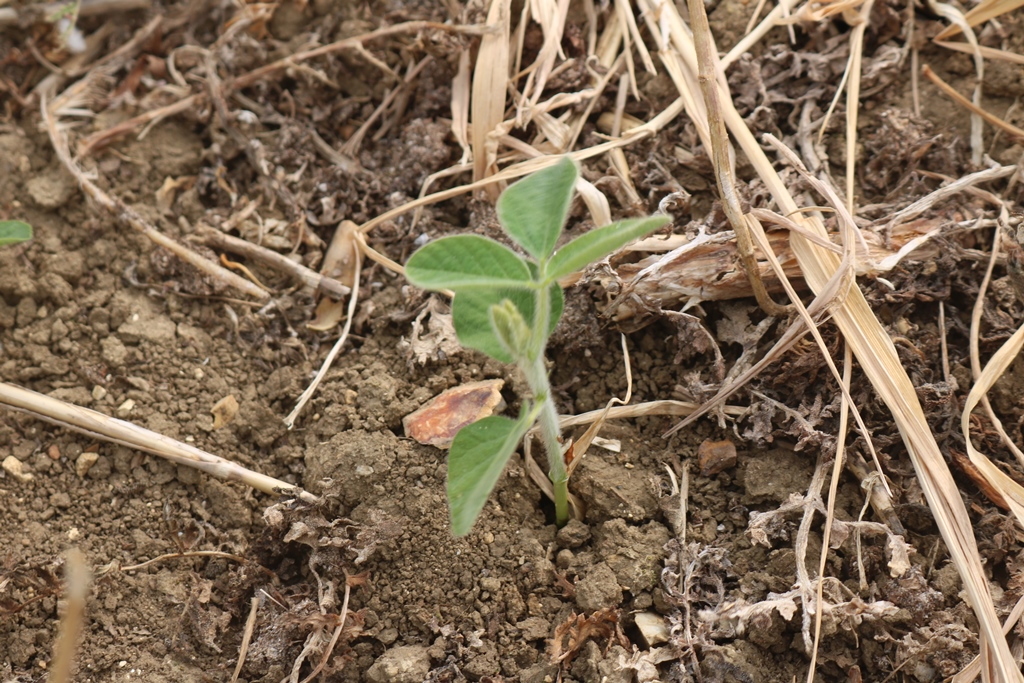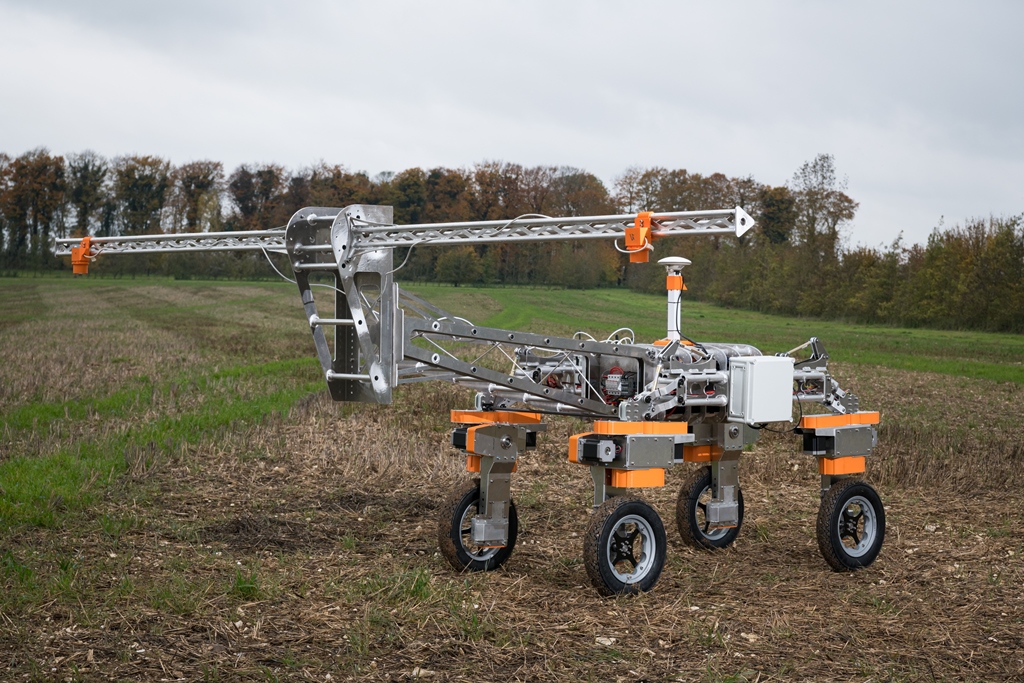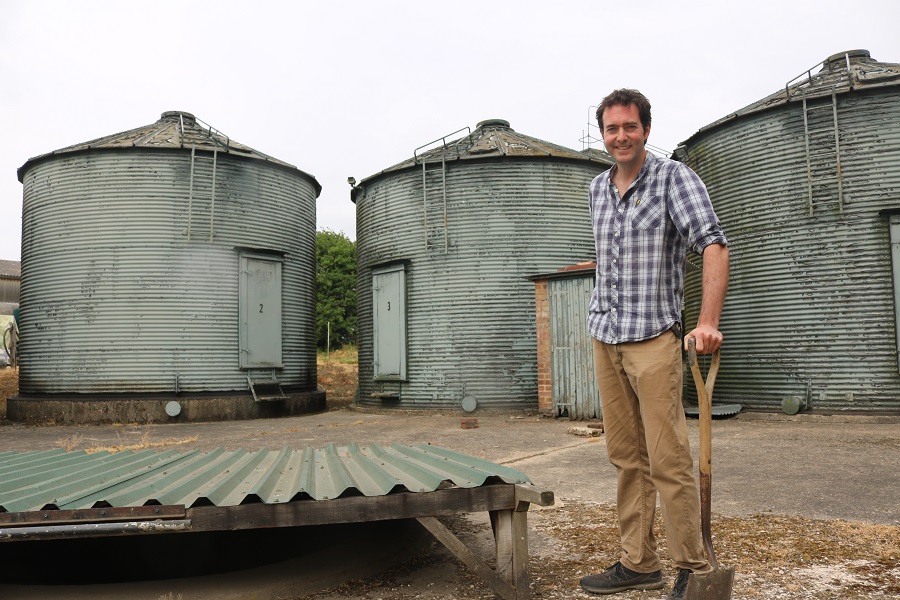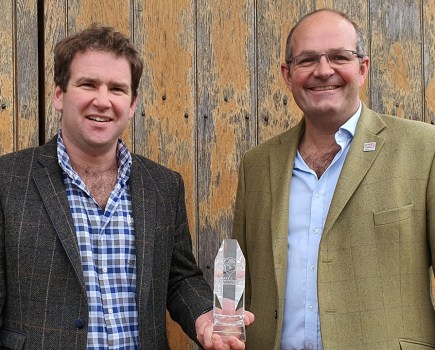A move towards regenerative agriculture has already delivered carbon savings for a Cambs farm. CPM visits to find out how autonomous robots are set to take this to the next level.
Surely a better way is to treat each plant individually, keep it healthy and give each one the resources it needs?
By Tom Allen-Stevens
Tom Pearson carefully extracts one soya plant from the clutches of his bone-dry Hanslope series chalky boulder clay. Although established well into a standing cover crop, it’s now visibly struggling with the prolonged lack of moisture and beset by pigeons.
But Tom doesn’t seem too upset. “What excites me about the journey we’re on is the prospect of per-plant farming,” he says. “It’s like the land’s on crack at the moment – we’re feeding our crops artificial inputs to drive production, while surely a better way is to treat each plant individually, keep it healthy and give each one the resources it needs?”
Based at Manor Farm, Caxton, near Cambridge, Tom farms 480ha in a family partnership and for the past five years has been taking it on a steady transition into regenerative agriculture. Soya is one of a number of spring-sown additions to the rotation, that include oats, linseed, peas and beans, grown alongside winter and spring barley, winter wheat and oilseed rape.

Tom Pearson is excited about the prospect of how per-plant farming can build on the progress he’s made towards regenerative agriculture.
“I like to try a new crop each year, while we’ve grown soya for the past three years. It offers a long window for cover crops, which really lie at the heart of regenerative agriculture. They’re part of the process of getting roots into the ground to do the job cultivations did previously, as well as build the soil’s biology.”
The farm purchased a John Deere 750A drill several years back, mainly to deal with the growing problem of blackgrass, the aim being minimum disturbance of the soil to limit blackgrass germination. “We took two fields out of the conventional system, mole-drained them and dug out the ditches, then put them into no-till with four years of spring cropping and cover crops.”
That area has expanded to around a fifth of the farm, with spring cropping now making up at least a third of the rotation. A variety of cover crops have been grown, some of which, such as buckwheat, he’s started to grow on to seed to lower establishment costs. “We benefit from a large number of small grain siloes, so we can store many different crops and grades in good condition – a diverse range of crops in the rotation is key.
“One aspect we’ve learned, though, is not to spray off the cover too early – there’s a lot of chat about green bridge and some spray it off as early as Nov. This year we drilled into green cover as much as one metre high. The roots put the soil in good condition with plenty of moisture available and we avoid the use a pre-emergence herbicide in the following cash crop although we do have to keep a close eye on the weed burden.”
Oilseed rape is still in the rotation and Tom’s approach is to drill early, at the start of August with a conventional variety such as Campus, sown with a companion crop. “We keep establishment costs low and never apply an insecticide. The worst thing about OSR is the endless worrying. So if it doesn’t establish, we still have a companion crop as a cover for a following spring crop. If the OSR survives, our yield of 3.3-3.4t/ha isn’t high, but still profitable in a low-input system.”
The aim is for year-round green cover, while chicken muck and pig slurry are applied to build organic matter. As well as moving to no-till, the farm’s adopting a controlled traffic farming philosophy, keeping wheelings to a minimum. “Our Grade 2 soils are generally in reasonable shape with organic matter ranging from 3.8-5.2%, but I’m very conscious of compaction. We have suffered a bit from slumping and can move any areas that need it. But every time you move the soil you go against the very ethos of regenerative agriculture. So we try to travel when it suits the soil best and ultimately the aim is for the plant roots to keep it in shape.”
Tom uses the Farm Carbon Toolkit to monitor progress towards a more sustainable system, but insists his strategy is not an ideological drive to return the farm to Nature. “Productivity is key – you cannot justify high yields if you’re using massive amounts of inputs to fuel them, but there’s no point in regenerative agriculture if it results in half the yield.” His yields have kept steady at 9.6t/ha for first wheat and above 9t/ha for a second wheat, while fuel use and cultivation costs have plummeted where land is direct drilled.

Currently carrying out pre-commercial trials, the two high-detail cameras mounted on SuperTom’s 4m boom are being replaced with six lower-detail devices.
The changes he’s made are small steps in a much longer journey, however, with per-plant farming being its ultimate destination. To that end, Tom is now involved with the Small Robot Company and is one of 30 farmers and agronomists on its Farmer Advisory Group. The company is developing a system that will replace large farm machinery with small autonomous robots. Tom, Dick and Harry are the monitoring, application and precision-planting farmbots and the approach is to work crops and fields to sub-centimetre accuracy, feeding information back and forth to Wilma, the artificial intelligence (AI) ‘brains’ behind the system.
The concept was launched just two and a half years ago, and having raised considerable funding and farmer support through two Crowdcube investment rounds, as well as government Agri-tech grants, SRC’s first prototype ‘SuperTom’ is currently going through its paces. The plan is to launch a limited initial service this autumn which will build as the technology is developed and the bots go into full production.
Tom (Pearson) is one of the first farmers to have signed up for the pre-commercial monitoring service. “I’m open to new ideas but not convinced large companies and corporations have the solutions to farming’s challenges,” he says. “SRC is farmer-led and those involved in developing the systems are genuinely driven towards making food production sustainable, reducing farming’s impact on the environment and increasing farm outputs.”
Ultimately, Tom sees major benefits from almost eliminating trafficking and compaction from every operation, apart from harvest. “We run our tyres at less than 10psi (0.7bar) but we’re still putting 9-12t on the soil whenever we travel. The SRC system is built on accuracy, not dependent on draught force, so doesn’t need the weight of kit needed in conventional agriculture. The resulting savings in diesel alone are huge before you’ve even factored in the benefits for the soil.”
That level of service is still at concept stage, however. The first stage is monitoring, and SuperTom can recognise wheat plants from weeds and pinpoint where they are. The bot’s made two visits to the farm so far this season with SRC robotics engineer Robin Jackson, but COVID-19 has put on-farm progress on hold.
“Tom’s signed up to plant and tiller counts and we should be able to accurately map 10ha in a day,” says Robin, who’s joined via web-conference. “In this first year, our focus has been on identifying and ironing out the practical difficulties and bugs.”
Mud sticking to SuperTom’s wheels has been an issue this season. The team has also determined that the farmbot’s two high-detail cameras mounted on a 4m boom are best replaced with six lower-detail devices that actually produce a higher quality image overall. “The quality of information we gather is superb – the AI brain sees a crop differently from a human and we’re learning new ways to interpret the data collected that offer real insight on the state of each plant. Computers are also patient and will systematically gather all the data needed.”
The grower involvement is invaluable for Robin in developing both the technology and the service. “Everything we bring back from the farm directly drives robot development and the AI, and we’re driven by how we can reduce the impact of farming on the soil. Problems may seem like barriers, but for us they’re not – at the end of the day we’re engineers working with farmers, and that’s the perfect way to solve problems.”
For Tom, it’s not just about accurate tiller counts. “This idea of per-plant nutrition is what I find really exciting. It offers opportunities to precision-apply nutrients. I can see you can develop in-field systems where different plants are co-operating, moving away from the monoculture modern agriculture has come to depend on, but without reducing productive capacity.”
He sees this as a natural progression of a crop-nutrition system he’s introducing as part of a whole farm approach to improve plant and soil health. Last year, Tom benefited from tissue testing carried out on his wheat crop entered into the Yield Enhancement Network (YEN). This year, he’s been working with Edaphos on a balanced nutrition programme, using foliar micronutrients, humates and fulvic acid to improve crop performance and lower dependence on traditional chemical inputs.
“From an N point of view, better utilisation results in a more healthy plant, so you’re not chasing disease. You can also slowly wean the plant off some N requirements without compromising yield, giving another opportunity to reduce carbon footprint,” he notes.
But monitoring this closely with SuperTom won’t just improve plant performance. SRC is adding an AI nose and ears to its prototype to pick up gaseous emissions and birdsong, for example. “Gathering this data will in time provide real evidence of how we’ve managed to sequester carbon and improve in-field biodiversity – that gives me a huge potential advantage both in terms of being rewarded for public goods and picking up premium markets,” says Tom.
“We’re in the heartland of human food production here, and already supply quality milling wheat and malting barley to local outlets. I’m actively looking to develop these premium markets and believe there’s potential for growers who can demonstrate a low-carbon, high-biodiversity production system.”
Tom feels he has every reason to be optimistic about the future. “There are concerns over climate change, but the steps we’ve taken so far show that regenerative agriculture can take us to net zero without any loss in productivity. Working with SRC puts you right in the mindset of agri-tech and the major shifts in technology that will revolutionise farming. Farming’s in a good place to deliver the changes society is calling for and the world needs.”
What makes Tom Pearson a Climate Change Champion?
Innovative ideas
In taking the farm towards regenerative agriculture, Tom has set long-term goals and has linked delivery of his ambition to the developing technology of autonomous robots. One of the first to take these on, he’s helping shape how the system evolves.
Productivity push
The farming system revolves around improving plant and soil health without compromising yields. This has been achieved through a measured introduction and roll-out, aiming to focus increasingly on the individual needs of each plant, thereby optimising output and minimising waste.
Cultivation care
The move to no-till goes hand-in-hand with changes to the rotation and cover crops, aiming to maintain all-year-round green cover and ensuring roots do the work instead of metal. Trafficking has also been minimised. The next stage is to take away heavy tractors altogether.
Bio-based boldness
While the farm is focused on achieving net zero food production, the farmhouse has a ground-source heat pump and carbon-neutral workspaces are being developed as a diversified enterprise.
A per-plant focus to achieve ambition of net zero emissions
Optimal yield, maximum profitability or a thriving environment – in farming to achieve at least two of these generally results in compromising on the third, believes Sam Watson-Jones, co-founder of the Small Robot Company. “Per-plant farming enables farmers to achieve all three with no compromise,” he says. “It’ll become the dominant system as farming goes through the fourth agricultural revolution.”
Per-plant farming is what SRC has set out to achieve and Sam maintains its Farming as a Service, that revolves around autonomous farmbots Tom, Dick and Harry and AI brains Wilma, will deliver it through:
- Greater accuracy – gathering data, making a diagnosis and taking action in a way that minimises resource use, taking considerable waste and needless expenditure out of the system.
- Minimal physical intervention – moving away from heavy, diesel-powered machines that turn the soil, to light electric-driven autonomous bots that don’t require draught force.
- Scientific delivery – understanding the soil and the growing environment and interpreting these to maximise plant growth and ensure the soil becomes a carbon sink.
“In two and a half years we’ve built a dedicated team, focused on delivering these ideals, and we’ve already reached considerable milestones that some may not have thought possible,” says Sam. “But what makes us different is that we’re led by farmers for the benefit of farmers.
“What immediately jumps out when you meet Tom Pearson is the long-term view and clarity of vision he has. Plant health lies at the heart of his way of farming and he builds biodiversity around it in an ecosystem in which everything interacts in a positive way. He has ambition to build on that, not just for himself but with other farmers, gaining knowledge and taking it beyond the confines of his own farm. That’s why SRC is pleased to support his nomination as Climate Change Champion 2020.”
Climate Change Champions
UK Farming has set itself the challenging target of Net Zero emissions by 2040. Although led by the NFU, it will take the entire industry, working together in a partnership approach to meet this ambitious goal.
But there are individual growers, thought leaders who have already started on this journey. They have the ideas, the progressive outlook and the determination to shape positive change. CPM has teamed up with leading agricultural suppliers who have a credible Net Zero aspiration to identify these individuals and bring them into the top-level discussion about how farming can position itself as the solution to climate change. CPM readers will get the chance later this year to decide who will be awarded the accolade of Climate Change Champion 2020.
CPM would like to thank our sponsors:
BASF, BKT, CF Fertilisers, KWS, Fendt, Interagro, Pottinger, Small Robot Company




